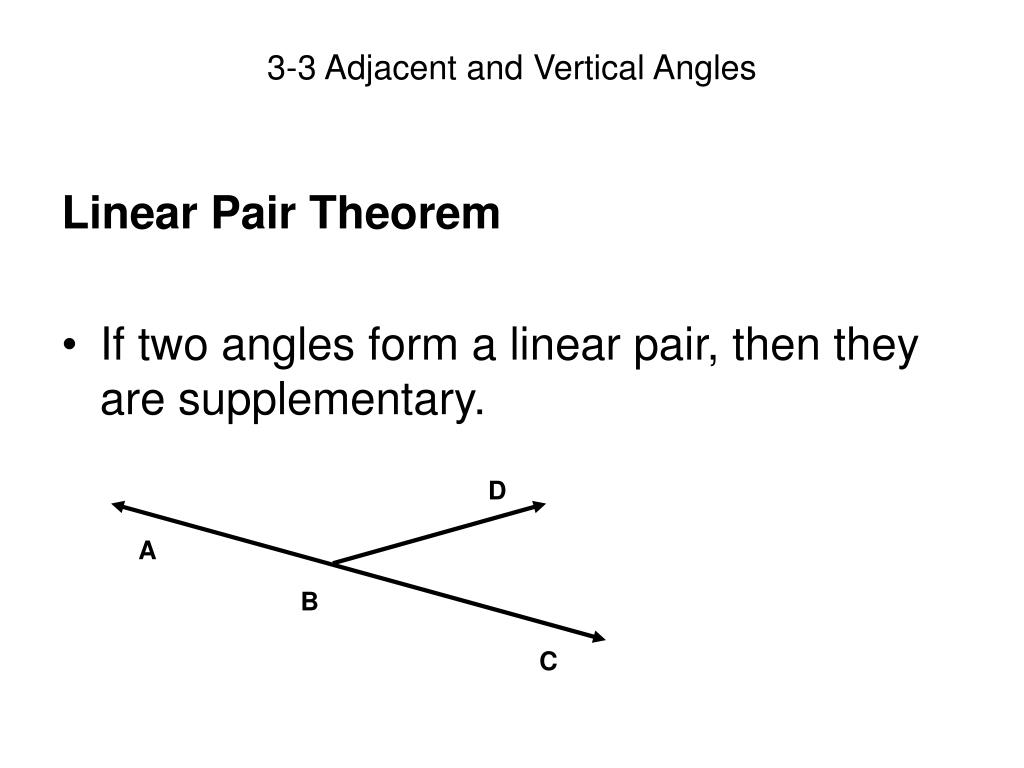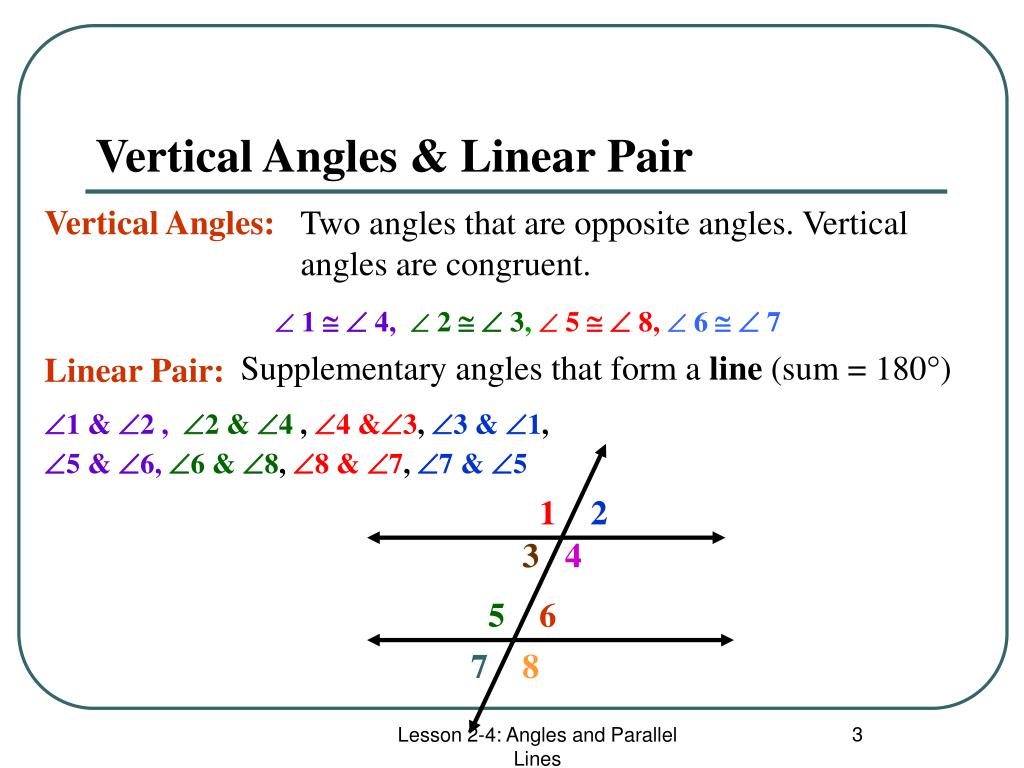Two Vertical Angles Form A Linear Pair - The angles are said to be linear if they are adjacent to each other after the intersection of the two lines. Web the concept of linear pairs is that if there is a straight line and another line intersects the straight line at a point, then. Sum of two adjacent supplementary angles = 180 o. Linear pairs of angles add to 180 o. In the figure, ∠ 1 and ∠ 2 form a linear pair. Web if two angles form a linear pair, then the measures of the angles add up to 180°. A linear pair of angles satisfy these two requirements (both must be true) the. Web vertical angles are a pair of nonadjacent angles, ∠1 and ∠2, formed by two intersecting lines. The measure of the smaller angle is one half the measure of the. Here are some examples of adjacent angles:
Vertical Angles and Linear Pairs YouTube
Linear pairs of angles add to 180 o. ∠1 and ∠3 are vertical angles ∠2 and ∠4 are vertical angles linear pair. Web two angles forming a linear pair are supplementary as there sum is 1 8 0 o. In the figure, ∠ 1 and ∠ 2 form a linear pair. A linear pair of angles satisfy these two requirements.
Which statement is true about this argument? Premises If two angles
A linear pair of angles satisfy these two requirements (both must be true) the. All linear pairs of angles are adjacent angles but all adjacent angles are not linear pairs. Web the concept of linear pairs is that if there is a straight line and another line intersects the straight line at a point, then. Learn the definition, properties, examples,.
Linear Pairs and Vertical Angles Example 2 YouTube
Sum of two adjacent supplementary angles = 180 o. Web two angles are said to be supplementary angles if the sum of both the angles is 180 degrees. Web two angles forming a linear pair are supplementary as there sum is 1 8 0 o. 1) the angles must be supplmentary 2) the angles must be adjacent in the picture.
NCERT Class 7 Mathematics Solutions Chapter 5 Linear and Angles
∠1 and ∠3 are vertical angles ∠2 and ∠4 are vertical angles linear pair. Such angles are also known as supplementary angles. Sum of two adjacent supplementary angles = 180 o. The angles are said to be linear if they are adjacent to each other after the intersection of the two lines. In the diagram above, ∠abc and ∠dbc form.
PPT 33 Adjacent and Vertical Angles PowerPoint Presentation, free
Linear pairs of angles add to 180 o. Here are some examples of adjacent angles: Learn the definition, properties, examples, practice. A linear pair of angles are always adjacent angles. In the figure, ∠ 1 and ∠ 2 form a linear pair.
PPT Lesson 2.6 Parallel Lines cut by a Transversal PowerPoint
Two angles that are adjacent (share a leg) and supplementary (add up to 180°) in the figure above, the two angles ∠. The measure of the smaller angle is one half the measure of the. Web the angles in a linear pair are supplementary (add up to 180 ∘ ). Web a linear pair is a pair of adjacent angles.
Linear Pair Of Angles Definition, Axiom, Examples Cuemath
Web the angles in a linear pair are supplementary (add up to 180 ∘ ). The measure of the smaller angle is one half the measure of the. Web if two angles form a linear pair, then the measures of the angles add up to 180°. Sum of two adjacent supplementary angles = 180 o. Web the concept of linear.
Planes, Lines and Transversals
Here are some examples of adjacent angles: Web a linear pair of angles has two defining characteristics: Sum of two adjacent supplementary angles = 180 o. All linear pairs of angles are adjacent angles but all adjacent angles are not linear pairs. Web the sum of two angles in a linear pair is always 180°.
PPT Lesson 24 PowerPoint Presentation, free download ID153630
Web two angles forming a linear pair are supplementary as there sum is 1 8 0 o. Sum of two adjacent supplementary angles = 180 o. Web the supplement of an interior angle is called an exterior angle, that is, an interior angle and an exterior angle form a linear pair of. Web a linear pair is a pair of.
Ex 5.1, 9 Adjacent Angles, Linear Pair of angles, Vertically Opposit
All linear pairs of angles are adjacent angles but all adjacent angles are not linear pairs. Web vertical angles are congruent (equal in measure). Web vertical angles are pairs of opposite angles formed when two lines intersect. Web the angles in a linear pair are supplementary (add up to 180 ∘ ). Web if two angles form a linear pair,.
Web when two lines intersect, the angles opposite to each other are equal and are called vertical angles or vertically opposite. Web the sum of two angles in a linear pair is always 180°. Web the supplement of an interior angle is called an exterior angle, that is, an interior angle and an exterior angle form a linear pair of. Web vertical angles are congruent (equal in measure). Web a linear pair is a pair of adjacent angles formed when two lines intersect. If the two supplementary angles are adjacent to each other then they are called linear pair. Web vertical angles are a pair of nonadjacent angles, ∠1 and ∠2, formed by two intersecting lines. A linear pair is two. Web two angles are said to be supplementary angles if the sum of both the angles is 180 degrees. Web two angles form a linear pair. Web linear pair of angles are formed when two lines intersect each other at a single point. Two angles that are adjacent (share a leg) and supplementary (add up to 180°) in the figure above, the two angles ∠. Learn the definition, properties, examples, practice. Such angles are also known as supplementary angles. If you think of the letter x. Linear pairs of angles add to 180 o. Web vertical angles are pairs of opposite angles formed when two lines intersect. Web angles \(\angle 1\) and \(\angle 3\) form a pair of vertically opposite angles, while angles \(\angle 2\) and. Web if two angles form a linear pair, then the measures of the angles add up to 180°. A linear pair of angles satisfy these two requirements (both must be true) the.
The Angles Are Said To Be Linear If They Are Adjacent To Each Other After The Intersection Of The Two Lines.
Web two angles form a linear pair. Web a linear pair of angles has two defining characteristics: Linear pairs of angles add to 180 o. Web the sum of two angles in a linear pair is always 180°.
In The Diagram Above, ∠Abc And ∠Dbc Form A.
Web the supplement of an interior angle is called an exterior angle, that is, an interior angle and an exterior angle form a linear pair of. If the two supplementary angles are adjacent to each other then they are called linear pair. Such angles are also known as supplementary angles. Web two angles forming a linear pair are supplementary as there sum is 1 8 0 o.
Web Linear Pair Of Angles Are Formed When Two Lines Intersect Each Other At A Single Point.
Web when two lines intersect, the angles opposite to each other are equal and are called vertical angles or vertically opposite. In the figure, ∠ 1 and ∠ 2 form a linear pair. A linear pair of angles are always adjacent angles. Web the concept of linear pairs is that if there is a straight line and another line intersects the straight line at a point, then.
Web The Angles In A Linear Pair Are Supplementary (Add Up To 180 ∘ ).
A linear pair of angles satisfy these two requirements (both must be true) the. The sum of angles of a linear pair is always equal to 180°. Web if two angles form a linear pair, then the measures of the angles add up to 180°. Web a linear pair is a pair of adjacent angles formed when two lines intersect.










